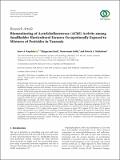| dc.description.abstract | Biomonitoring of pesticides exposure has currently become a matter of great public concern due to the potential health effects of
pesticides. ,is study assessed levels of acetylcholinesterase (AChE) inhibition and associated health effects in uncontrolled
smallholder farming systems in rural Tanzania. A cross-sectional study was conducted of 90 exposed farmers and 61 nonexposed
controls from horticultural zones. A structured questionnaire was administered, and a capillary blood sample of 10 μl was used to
measure AChE activity using an Erythrocyte Acetylcholinesterase Test Mate Photometric Analyzer kit (Model 400). A multiple
logistic regression model was used to investigate determinants of pesticide exposure. ,e study revealed that smallholder farmers
are occupationally exposed to pesticides. Exposed farmers had significantly lower AChE levels. ,e use of personal protective
equipment (PPE) did not significantly reduce the likelihood of AChE inhibition. Women, younger and older farmers, and
underweight, overweight, and obese farmers were at increased risk of AChE inhibition. Increase in age (10 years) increased
likelihood of AChE inhibition by 6.7%, while decrease in BMI increased likelihood of AChE inhibition by 86.7% while increased
pesticides contact hours increased risk of having lower AChE at about 3 times. ,e number of exposure symptoms (14.10 ± 7.70)
was higher in exposed farmers than unexposed. Self-reported symptoms are confirmed to correlate to lower AChE. Prevalence of
tiredness (71.6% against 15.5%), fatigue (64.8% against 27.6%), soreness in joints (59.1% against 20.7%), thirst (52.3% against
12.1%), skin irritation (52.1% against 17.2%), salivation and abdominal pain (50% against 8.6% and 31.0%, respectively), muscle
weakness (47.7% against 24.1%), and memory loss (47.7% against and 29.3%) differed significantly between exposed and control.
,is study provides useful information regarding the level of occupational and environmental exposure to pesticides in
smallholder horticultural production systems. Pesticides use needs to be controlled at farm level by developing pesticides
monitoring and surveillance systems. | en_US |

